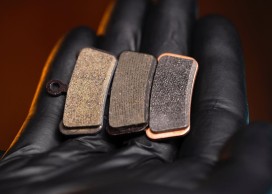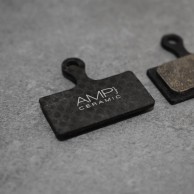What brake pads do you need?
Almost more important than being able to go fast on your bike is being able to stop it in time, which is why brakes are arguably the most important component of any bike. Disc brakes are now standard on road and mountain bikes for safety and reliability, but they also require maintenance. Let's take a look at what kind of disc brake pads are available and what their advantages and disadvantages are.

When to change disc brake pads?
Many cyclists rely on the sound to tell them when to change their brake pads, but when they start to make a metallic sound it means that the pad has been pushed too hard and the metal part is starting to rub on the rotor, it is definitely time to change them.
Although it is usual for brake pads to last 6 to 12 months, the truth is that it depends on factors such as climate, use and intensity, the type of cyclist, etc. So we suggest that you don't wait so long and check your brake pads from time to time, so you can anticipate the wear of the discs and extend the life of your disc brakes.
Parts of bicycle brake pads
RECOMENDADO

What is heart rate variability and how does it affect the cyclist?

Change wheels if you want to transform your bike's behavior

What bike size do you need? Here's how to find out

How does age affect performance and recovery?

How long cyclists can be pushed when handed a sticky bottle?

10 tips for safer and faster downhills on road bikes
The brake pads go inside the brake caliper and embrace the disc without touching it until the caliper pistons are actuated by the brake lever. This mechanical-hydraulic mechanism is as simple as it is effective and powerful, but if you have never dismantled a brake pad before, here are the parts you need to know.
- Pin: This is metal and goes through the top of the pads and the spring. It is the first thing you must remove to be able to take the pads out of the caliper.
- Spring: when you remove the pads, you will see that both are coupled to a metal spring that opens the pads when you stop applying the brake. It is advisable to change this spring together with the pads.
- Support: The brake pad consists of a support to which the compound is added. The support is usually made of metal, ceramic or carbon.
- Compound: this is the part that makes contact with the brake disc and is responsible for reducing speed through friction with the disc. Below is a complete classification of the types of brake pads according to compound.

Disc brake pad types: organic, metallic or sintered
When it comes to changing your brake pads, you may not be sure which ones to fit as there is a wide variety of models and with different compositions. The most important thing to know is that each disc brake manufacturer uses pads of different sizes and shapes depending on the brake model, so it is best to disassemble your pads and buy ones of identical shape and size.
Once this classification has been made, you can still choose from a wide variety of models, depending on the composition.

Organic disc brake pads
Organic brake pads, also called resin brake pads, are the most commonly used brake pads and are made from a conglomerate of organic and inorganic substances that are compacted by resins.
Advantages of organic pads
- Very good initial response
- They are made of a soft material that favours the braking feel
- They cause less noise
- Better preservation of the disc brake caliper by not transmitting heat to the caliper
Disadvantages of organic pads
- They are consumed sooner
- When used continuously they can heat up and lose effectiveness
- They are susceptible to crystallisation
Metallic or sintered disc brake pads
Made of small metallic compounds - copper, bronze or iron - and bonded together by heat, these pads are known as metallic or sintered pads and are used in harsh environments where an all-terrain pad is needed.
Advantages of metal pads
- Very durable, metallic materials last longer
- Withstand high temperatures without affecting braking performance
- They behave well in mud, water, humidity, etc.
Disadvantages of metal pads
- They wear disc brakes more, both disc and caliper, as they conduct heat to the rest of the braking system.
- They take some time to start braking well
- They cause more noise

Apart from these two types of brake pads, there is a third type known as semi-metallic brake pads, which combines the virtues and disadvantages of organic and metallic brake pads, but their use is not as widespread and requires special conditions. What type of brake pads do you use for disc brakes?